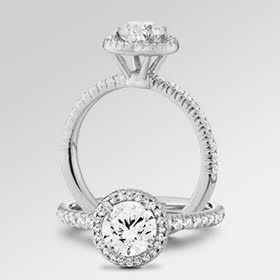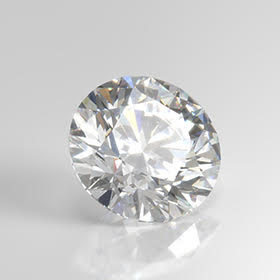Round diamonds, like any other diamonds, are formed deep within the mantle of Earth. They are formed here under intense heat and pressure. The formation process begins with carbon, which is present in the Earth’s mantle in the form of carbon-rich minerals. These minerals are subjected to high temperatures and pressure in the mantle. It causes them to melt and form magma.
How is Diamond Formed?
Over millions of years, the magma that contains this carbon rises to the Earth’s surface through volcanic eruptions. As the magma cools and turns into a solid state, they form igneous rocks and are known as kimberlite or lamproite. These rocks act as a natural pipe that transports diamonds from the mantle to the Earth’s surface.
While the diamonds are still deep in the Earth, they exist in a rough, unpolished form known as diamond rough or diamond crystal. These rough diamonds have an octahedral shape. It means that the diamond rough has eight faces. Once the kimberlite or lamproite rocks reach the surface through volcanic activity, they form cone-shaped deposits called kimberlite or diamond pipes. These pipes can range from a few meters to several kilometers in diameter.
The diamond rough within these pipes undergoes a transformation due to the volcanic eruption. These eruptions are violent and rapid. And it causes the kimberlite or lamproite to explode, creating a type of volcanic crater called a maar. This explosive force of eruption shatters the diamond rough into fragments. It scatters around the volcanic crater. Over time, the diamond fragments are washed away by rivers and streams, eventually depositing them in alluvial deposits like riverbeds, gravel bars, and ocean floors.
This raw product is then polished and cut to create the final product. Diamond, which is the final product, can be cut in various styles. These cuts include cuts like rose cut, princess cut, emerald cut, pear cut, oval cut, round cut, radiant cut, and Asscher cut diamonds. There are several more cuts of diamonds.
Colors of Fancy Man Made Diamond
Fancy man made diamonds come in various colors. The various colors of fancy manmade diamond include white, blue, pink, yellow, green, orange, black, purple, red, grey, brown, and olive. These diamonds are created in a laboratory using advanced technology. Read on to learn more about these fancy manmade diamonds here:
-
Blue Diamonds
Natural blue diamonds are very rare. These diamonds are hunted by collectors all over the world. The blue color of the diamond is a result of boron impurities. Sometimes, these diamonds are formed due to radiation exposure and hydrogen. The presence of boron is rare in diamond formation, which is the main reason these diamonds are so rare.
-
Pink Diamonds
In nature, the presence of a pink diamond is very rare. Reportedly, trace elements have never been found in pink diamonds. The coloration of the pink diamond is caused by a distortion in the diamond’s crystal lattice. It is created by intense heat and great pressure. Pink manmade diamonds are formed in a lab by replicating the same process that occurs in nature.
-
Yellow Diamonds
Yellow diamonds are greatly in trend. In nature, the fancy yellow color in diamonds comes from the presence of nitrogen in the crystal lattice. Due to the presence of nitrogen atoms and their special arrangement, they absorb more light from the blue end of the color spectrum. This is why the diamond gets its yellow appearance.
-
Purple Diamonds
Purple diamonds can be created in the lab using advanced technology. However, natural purple diamonds are quite rare. They are one of the rarest diamonds in the world. In nature, purple diamonds are formed due to the presence of elements like boron and hydrogen. Due to large amounts of hydrogen and boron, natural diamonds get a purple color.










